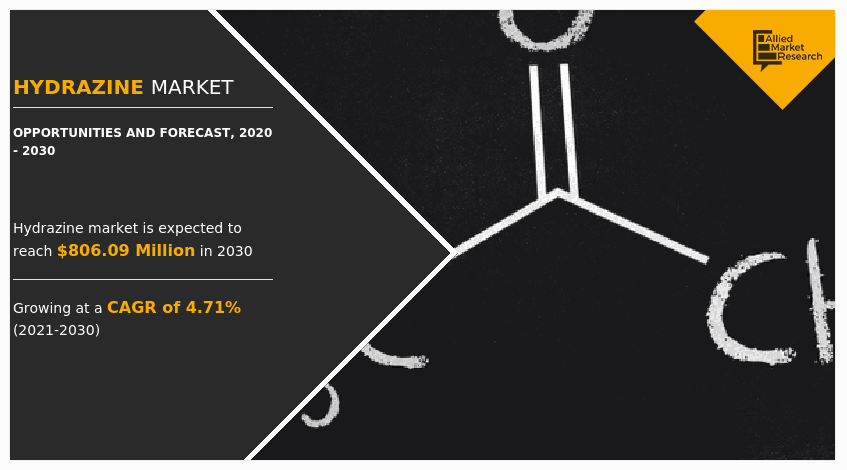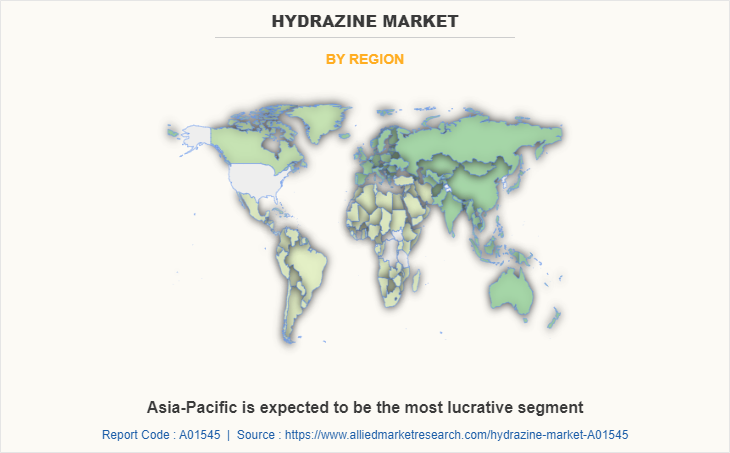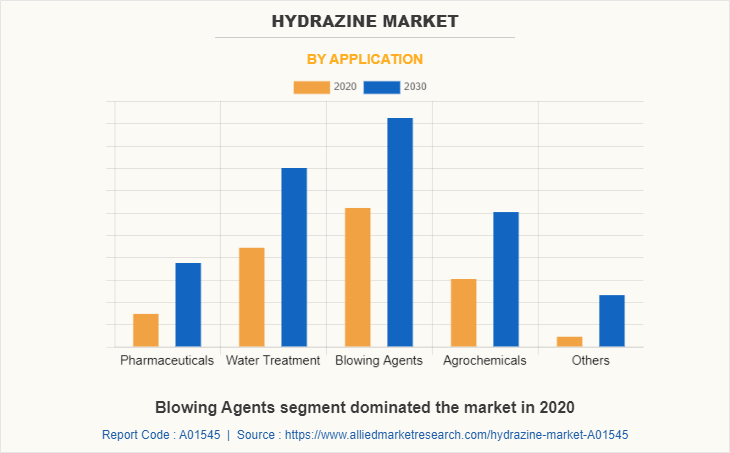Hydrazine Market Research, 2030
The global hydrazine market was valued at $510.95 million in 2020, and is projected to reach $806.09 million by 2030, growing at a CAGR of 4.71% from 2021 to 2030.

Hydrazine is a toxic, colorless sensitizer and irritant in its anhydrous form, which damages the central nervous system and causes seizures and tumors. It has a pungent smell and is a powerful reducing agent. It is highly explosive in unstable state. Hydrazine is mainly used during polymerization and for treatment of water. It is also used as rocket fuel and for preparation of gas precursors used in air bags in automobiles. Moreover, hydrazine is used in space vehicles in the form of propellant to reduce the overall concentration of dissolved oxygen. In addition, it finds major use in industrial boilers to control the pH of water.
Production of hydrazine involves various processes such as Raschig process, urea process, and H2O2 process. Among all these, the Raschig process is the most widely used process for commercial production of hydrazine. The chemical majorly finds its application in production of foaming agents, such as azodicarbonamide. When azodicarbonamide is bubbled via a liquid polymer precursor, it decomposes to nitrogen, carbon monoxide, carbon dioxide, and ammonia thermally. Hence, these gases further form bubbles in hydrazine liquid, thus polymerize to leave a foamy and lightweight plastic.
Presently, the global hydrazine market witnesses vivid opportunities, owing to rise in demand for polymer foams in the polymer industry. Different applications of hydrazine in products such as foamed core pipes, food containers, structural foam, wood grain furniture, and vinyl sheets is another factor anticipated to propel growth of the global hydrazine market during the forecast period. In addition, growth in need for agrochemicals, owing to rise in demand for high quality agricultural products, especially for food is another key aspect that drives the global hydrazine market. Presence of extreme toxicity of hydrazine is one of the key elements anticipated to pose serious threats to the global hydrazine market. Furthermore, various environmental and industry regulations imposed by the National Institute for Occupational Safety and Health and OSHA, U.S. is also a major restraint for the global market.
The global hydrazine market is segmented on the basis of application and region.
By application, the hydrazine market is classified into halocarbons pharmaceuticals, water treatment, agrochemicals, blowing agents, and others. The global hydrazine market forecast is analyzed across North America, Europe, Asia-Pacific, and LAMEA. Asia-Pacific accounted for the largest market share of the total revenue in 2020, followed by North America and Europe. High adoption of hydrazine products in the region would continue to propel the hydrazine market size, owing to presence of huge population base and presence of many developing countries in this region.
Key players operating in the global hydrazine market are Arkema Inc., Bayer AG, Fisons plc, Arrow Fine Chemicals, Arch Chemicals, Inc., Nippon Carbide Industries Co. Inc., Japan Finechem Company, Inc., Lanxess AG, Lansdowne Chemicals, and Hidkim. The other players in the value chain include Chemtex Specialty Limited, Palm Commodities International Inc., Seidler Chemical Company, Charkit Chemical Corporation, BOC Sciences, Spacechem LLC, GFS Chemicals Inc., Chemicals Incorporated, Haviland Enterprises Inc., Layson Bio, Inc., Spectrum Chemicals and Laboratory Products, and Mil-Spec Industries Corpare competing for the share of the market through product launch, joint venture, partnership, and expanding the production capabilities to meet the future demand for the hydrazine market during the forecast period.

Asia-Pacific occupies largest part of the hydrazine market and consists of countries such as China, India, Japan, South Korea, Australia, and rest of Asia-Pacific. This is a region with largest consumption from countries, such as China and India. India and China have the largest agricultural areas worldwide, with 11% and 10% shares, respectively, of the total arable land of the world, thus, indicating a continuous demand for agrochemicals. Hydrazine is used in the pharmaceutical industry. Isoniazid, an antibiotic for the treatment of Tuberculosis is prepared using hydrazine. According to the World Health Organization (WHO), greatest number of Tuberculosis patients were found in six Asian countries. Increase in hydrazine application for refining and purification process in emerging regions such as Asia-Pacific is expected to drive demand and positively impact the hydrazine market growth during the forecast period.

The blowing agent segment dominates the global hydrazine market share. Hydrazine is applied when the blown material is in its liquid stage. The use of hydrazine as a precursor to blowing agent creates a cellular structure and reduces density, increases acoustic and thermal insulation as well as the overall relative stiffness of the parent polymer. Thus, increasing demand for high strength and efficient polymers across various end-use industries is a key factor driving demand for hydrazine as a precursor to blowing agents.
COVID-19 Impact analysis:
COVID-19 has severely impacted the global economy with devastating effects on global trade, which has simultaneously affected households, business, financial institution, industrial establishments, and infrastructure companies. Restrictions on international trade and lockdown regulations on operations of the chemicals industry are projected to limit short term demand in the market.
Further, foam manufacturers are being forced to shut down or limit production processes for non-essential applications. However, demand for hydrazine hydrate in pharmaceutical and water treatment segments are unlikely to be affected by the coronavirus crisis. Applications as pharma intermediates and demand for potable water are expected to help to partially mitigate any losses arising during this time.
Key Benefits For Stakeholders
- This report provides a quantitative analysis of the market segments, current trends, estimations, and dynamics of the hydrazine market analysis from 2020 to 2030 to identify the prevailing hydrazine market opportunities.
- The market research is offered along with information related to key drivers, restraints, and opportunities.
- Porter's five forces analysis highlights the potency of buyers and suppliers to enable stakeholders make profit-oriented business decisions and strengthen their supplier-buyer network.
- In-depth analysis of the hydrazine market segmentation assists to determine the prevailing market opportunities.
- Major countries in each region are mapped according to their revenue contribution to the global market.
- Market player positioning facilitates benchmarking and provides a clear understanding of the present position of the market players.
- The report includes the analysis of the regional as well as global hydrazine market trends, key players, market segments, application areas, and market growth strategies.
Hydrazine Market Report Highlights
| Aspects | Details |
| By Application |
|
| By Region |
|
| Key Market Players | ARKEMA INC., NIPPON CARBIDE INDUSTRIES CO. INC., HIDKIM, JAPAN FINECHEM COMPANY, ARROW FINE CHEMICALS, BAYER AG, FISONS PLC, LANSDOWNE CHEMICALS, ARCH CHEMICALS INC., LANXESS AG |
Analyst Review
Hydrazine is widely used as a propellant precursor for water treatment and boilers. The propellant segment is expected to witness significant growth during the forecast period, owing to increase in use for hydrazine in thermal power plants. Pesticides, herbicides, and pesticides are some of the new uses for hydrazine and its derivatives. Hydrazine finds extensive applications in the pharmaceutical sector for manufacturing drugs. It is also used as chemical blowing agents, photography chemicals, textile dyes, boiler water treatment for corrosion protection, and as fuel for rockets and spacecraft around the world. Other significant uses of hydrazine include redox reactions, polymerization catalyst, nuclear fuel reprocessing, metal electrolytic plating on glass and plastics and a scavenger for gases.
Growth of the hydrazine market is driven by high demand from water treatment plants and various pharmaceutical companies. The agrochemicals segment offers maximum market potential in the global hydrazine market, owing to rapid development and advancements in technologies adopted in production of agricultural products. In addition, rapid urbanization, rise in global population, change in climatic conditions, and decline in arable land area result in increasing shortage of food and demand for pesticides in the agriculture industry, which is propels the market growth. Furthermore, owing to stringent governmental policies on utilization of exhaustible fuels and use of hydrazine is increasing for reducing carbon emissions in the environment.
The Asia-Pacific hydrazine market offers promising opportunities for manufacturers due to boom in the thermal power sector. In addition, rise in disposable income in developing countries such as China, India, and Japan drives the hydrazine market in Asia-Pacific. Demand for efficient water treatment equipment and improved advanced pesticides also complement the market growth.
Increase in demand for hydrazine as a reducing agent and surge in demand for high quality agrochemicals are the key factors boosting the Hydrazine Market growth
The market value of Hydrazine in 2030 is expected to be US$ 806.1 Million
Arkema Inc., Bayer AG, Fisons plc, Arrow Fine Chemicals, Arch Chemicals, Inc., Nippon Carbide Industries Co. Inc., Japan Finechem Company, Inc., Lanxess AG, Lansdowne Chemicals, and Hidkim.
Pharmaceuticals industry is projected to increase the demand for Hydrazine Market
The global hydrazine market is segmented on the basis of application and region. Based on application, the hydrazine market is classified into halocarbons pharmaceuticals, water treatment, agrochemicals, blowing agents and others. The global hydrazine market is analyzed based on four regions, which include North America, Europe, Asia-Pacific, and LAMEA.
Increase in research and development related to hydrazine in pharmaceutical applications is the Main Driver of Hydrazine Market
Chemical industry is expected to drive the adoption of Hydrazine
foam manufacturers are being forced to shut down or limit production processes for non-essential applications. However, demand for hydrazine hydrate in pharmaceutical and water treatment segments are unlikely to be affected by the coronavirus crisis. Applications as pharma intermediates and demand for potable water are expected to help to partially mitigate any losses arising during this time.
Loading Table Of Content...



